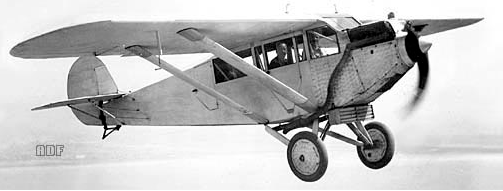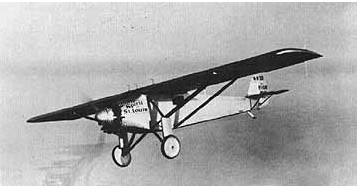Mail Plane to History Maker
by Fitz Walker
Today, a very odd design feature. The University of Houston presents this program about the machines that make our civilization run, and the people whose ingenuity created them.
I recently spoke with a co-worker about our past vacation travels. Since he knew my interest in aircraft, he mentioned that he'd visited the National Air and Space Museum in Washington DC. Naturally that piqued my interest. I asked what he'd seen there. He wasn't familiar with aviation history and could give only general descriptions. But he found one aircraft so unusual that he couldn't forget it.
He said this particular plane seemed rather basic looking except that it had no front windows. The fact that the pilot of such a craft could not see where he or she was going baffled him. It was a vague description of the vehicle, but I immediately knew what aircraft he was talking about.
The airplane in question is a derivative of the Ryan M-1. A 1920's era single engined aircraft with a parasol wing above the fuselage. The M-1 is known for being America's first production civil airplane. It's a simple design with a metal tube frame and fabric covering.
With two open cockpits and a fixed undercarriage, it's not too far removed from the rickety biplanes made just a few years earlier. The M-1 then became the M-2. It was still the same basic aircraft, except now with the comfort of a fully enclosed cockpit and extra passenger space.
Ryan M-2 mail & passenger plane.
The Ryan M-2 became one of the most successful civilian aircraft of the mid 1920's. Flying mail and cargo mostly along the entire west coast, the M-2 was so cheap to operate that freight and passenger service companies could actually turn a profit. It proved that there was a future in commercial aviation.
Still, the attrition rate among these planes tended to be pretty high as bad weather often made flying these routes extremely dangerous. Regardless, the burgeoning air mail transport businesses benefited greatly from the M-2's sturdy design. There are examples of these Ryan planes that can still fly even today.
This leads back to that little Ryan plane my co-worker saw in the Smithsonian. The actual name of that plane is the Ryan NYP. The letters NYP meaning New York to Paris. Most of us, however, know it as the Spirit of St. Louis. Yes, that very same plane Charles Lindbergh famously used to become the first person to fly non-stop across the Atlantic Ocean.
Lindbergh's Spirit of St. Louis
When hearing of Lindbergh's plan to cross the Atlantic Ocean, the Ryan company offered to build him a special airplane based off their popular M-2. The Spirit of St. Louis was that plane. However, lots of changes were made to it in order to facilitate long duration flying.
Now as for the reason why there are no front windows in Charles Lindbergh's Atlantic crossing plane. It's very simple: that is where the gas tank was. Carrying enough fuel for the trip required such a large gas tank that it blocked the use of front windows. Lindbergh had to fly almost the entire 34 hour trip looking out of the side windows or through a small periscope.
And that's something to think about next time you are overly concerned about a dirty windshield on your car.
I'm NASA engineer Fitz Walker on behalf of the University of Houston, interested in the way inventive minds work.
Both images courtesy of www.centennialofflight.gov.
Lindbergh, Charles. We: The Daring Flyer's Remarkable Life Story and his Account of the Transatlantic Flight that Shook The World. Lyons Press , 1927.
Hardesty, Von. Lindbergh: Flight's Enigmatic Hero. Harcourt, Inc., 2002.
Ryan M-1 at The Museum of Flight: http://www.museumofflight.org/aircraft/ryan-m-1
This episode was first aired on March 16, 2012.

